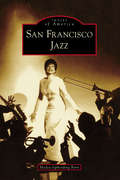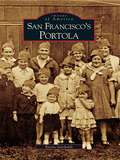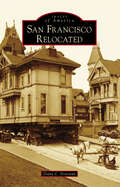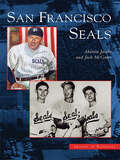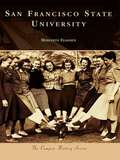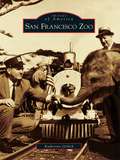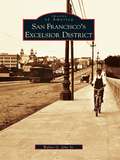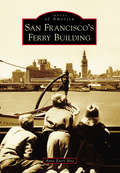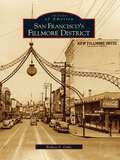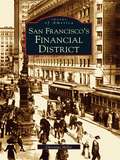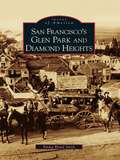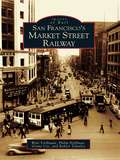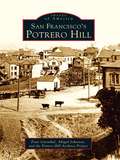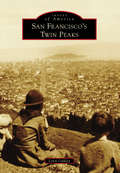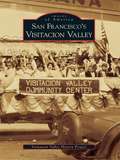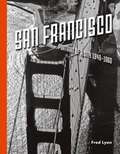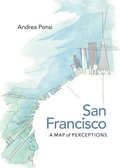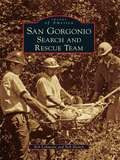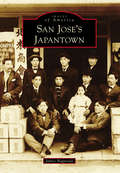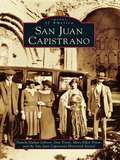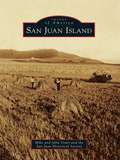- Table View
- List View
San Francisco Jazz
by Medea Isphording BernSan Francisco is probably best known for its hills, ubiquitous fog, dungeness crab and the Golden Gate Bridge. But jazz music's threads are similarly woven into the fabric of the city and its environs. Whether performed in renowned clubs like So Different, Jimbo's Bop City, Black Hawk, and the Jazz Workshop or in halls like the Primalon Ballroom and Great American Music Hall, jazz has infused the city from the Barbary Coast to the Fillmore, thrilling audiences for over a century. San Franciscans have grooved to and incubated scores of jazz acts, hot and cool, raucous and contemplative. That tradition continues today.
San Francisco Noir
by Fred LyonFollowing in the footsteps of classic films like The Maltese Falcon and The Lady from Shanghai, veteran photographer Fred Lyon creates images of San Francisco in high contrast with a sense of mystery. In this latest offering from the photographer of San Francisco: Portrait of a City 1940–1960, Lyon presents a darker tone, exploring the hidden corners of his native city. Images taken in the foggy night are illuminated only by neon signs, classic car headlights, apartment windows, or streetlights. Sharply dressed couples stroll out for evening shows, drivers travel down steep hills, and sailors work through the night at the old Fisherman's Wharf. Stylistically, many of the photographs are experimental the noir tone is enhanced by double exposures, elements of collage, and blurred motion. These strikingly evocative duotone images expose a view of San Francisco as only Fred Lyon could capture.
San Francisco Portola
by Rayna GaribaldiThe Portola has a long and unique history dating back to the late 1800s. Too often misidentified with neighboring districts, it has its own story to reveal. Originally settled by Jewish immigrants, the area evolved into a community populated by nurserymen and their families who grew much of the city's flowers. "The Road," as San Bruno Avenue was affectionately referred to by the locals, hosted businesses that included bakeries, grocery stores, pharmacies, and a theatre. In recent years, the Portola has undergone changes as community leaders have enacted programs to beautify the neighborhood and attract new businesses and families to this locale.
San Francisco Relocated
by Diane C. DonovanSan Francisco's colorful history has been explored so extensively that it is surprising to note that its moved buildings remain one of the city's best-kept secrets. Reports are widely scattered in newspapers and architectural references; yet, despite the fact that the city's relocations are second only to Chicago's, there are no books in print concerning this curious history--until now. And it is a long, lively tale indeed. Beginning in 1850 and continuing today, it involves hundreds of moved structures, from houses and apartment buildings to churches and schools. Buildings were relocated for many reasons, from street modifications in the early 1900s to the advent of freeways and Bay Area Rapid Transit (BART) in the 1950s and 1960s. Buildings were cut in half and moved in pieces, disassembled and moved brick by brick, or (more commonly) moved intact--some as heavy as 9,000 tons or as long as 110 feet. Buildings moved to San Francisco via ship around Cape Horn, traveled across town using horses and wagons or (later) trucks, and were barged over the Bay.
San Francisco Seals (Images of Baseball)
by Martin Jacobs Jack McguireFor more than half a century, San Francisco Seals baseball was a fertile source of future major league players, with a legacy firmly grounded in the annals of Pacific Coast League baseball. Paul and Lloyd Waner, Ping Bodie, Earl Averill, William Kamm, Ferris Fain, Harry Heilmann, Smead Jolley, "Lefty" O'Doul, Frankie Crosetti, the DiMaggio brothers (Joe, Vince, and Dom), Larry Jansen, and others all launched their careers as Seals. From 1903 to 1957, the Seals were the toast of the town, offering tight pennant races and intense games with the Oakland Oaks--their cross-bay rivals--while playing at Recreation Park and Seals Stadium. In almost 6 decades, the Seals won 11 pennants and 4 Governor's Cups. They survived the earthquake and fire of 1906, the Great Depression, and two world wars. Never forgotten will be Smead Jolley, who in 1928 had what many consider the best all-around season in PCL history by hitting .404 and winning the Triple Crown; Gus Suhr's record-breaking 51 homeruns in 1929; Joe DiMaggio's 61-game hitting streak during his 1933 rookie season; and pitcher Bob Joyce's 31 victories and 35 complete games in 1945.
San Francisco State University
by Meredith EliassenSan Francisco State University has promoted educational excellence for more than a century. Established as a vocational school for teachers, it became the first such institute in the United States to require a high school diploma. As the school expanded its curriculum, it became San Francisco State Teachers College (1921), San Francisco State College (1935), and San Francisco State University (1972). Known as "the City's University," San Francisco State is situated on a park-like campus in the southwest corner of San Francisco. The school's motto--"experience teaches"--communicates its pragmatic approach to education, and SFSU has developed many internationally respected programs over the years. The school's fascinating history includes complete destruction by the 1906 San Francisco earthquake and fire, as well as a five-month student/faculty strike during the late 1960s, which resulted in the founding of the first School of Ethnic Studies (1969) in the United States.
San Francisco Zoo
by Katherine GirlichIn 1922, philanthropist and president of the San Francisco Parks Commission, Herbert Fleishhacker, purchased a 60-acre site in southwestern San Francisco. Fleishhacker Pool was built in 1925 and an adjoining zoo added in 1929. Originally called Fleishhacker Zoo, it featured a variety of exotic wildlife. Major exhibits were built in the 1930s Depression era as part of the Work Progress Administration (WPA). This book celebrates the San Francisco Zoo's 80-year history as it revisits cherished animals and structures like Monkey Island, Storyland, and Dentzel Carousel. The zoo holds a special place in the hearts of many, as it is a great San Francisco treasure along the foggy shores of Ocean Beach.
San Francisco's Excelsior District
by Walter G. Jebe Sr.The Excelsior District traditionally has not been among San Francisco's "spotlight" neighborhoods, yet this area is an important residential and commercial zone that is home to some 30,000 residents. These rolling hills south of San Francisco's better-known districts are now covered with row upon row of houses, streets, and apartments. But places like the Excelsior were once sparsely populated, agrarian, and even rural. This volume of vintage photographs chronicles the Excelsior's intriguing journey from rugged swamp and farmland to the busy cosmopolitan neighborhood we know today. It is a tale of determined immigrant families putting down roots in a challenging locale and overcoming adversity to stake out a permanent enclave in this famed city. It is also a story of large-scale construction and reclamation to tame the rugged outskirts of San Francisco.
San Francisco's Ferry Building
by Anne Evers HitzFor many years, visitors traveling to San Francisco came via ferry, and the Ferry Building, one of San Francisco’s most famous landmarks, stood ready to welcome them. In the 1920s, the Ferry Building was the world’s second-busiest transit terminal (after Charing Cross, London), with more than 50,000 people a day passing through the elegant structure, designed by architect A. Page Brown and opened in 1898. When the 1906 earthquake struck and the ensuing fire was destroying the city, the venerable waterfront icon stood above the ruins, giving residents hope that the city would recover and rise from the ashes. By 1939, with the Golden Gate Bridge and the Bay Bridge both open, ferry traffic fell off. By the late 1950s, ferry service ended altogether, and the building’s beautiful facade was blocked by the double-decker Embarcadero Freeway. With the freeway’s demise after the 1989 Loma Prieta earthquake, the Ferry Building was restored and reopened in 2003. It is once again a beacon of civic pride, a landmark listed in the National Register of Historic Places, and a public space that anchors the San Francisco waterfront.
San Francisco's Fillmore District
by Robert F. OaksToday's Fillmore District, while one of San Francisco's most diverse neighborhoods, bears little resemblance to the cosmopolitan place it once was. This district, which has arguably changed more than any other in the city, once held a large Jewish settlement, replete with synagogues, bakeries, and kosher markets. It also had a huge Japanese community, now centered in Japantown but not as extensive as in the prewar years; amusements like the Chutes, Dreamland boxing ring, and theatres; schools, churches, and a celebrated "Jazz District" that hosted the top names in music for many years. And in one of the most controversial displays of civic power, this densely populated area fell to the forces of redevelopment, bisected by the ambitious plan to widen Geary Boulevard, creating a freeway-like road through the district and forcing out thousands of dwellers whose homes were either moved or demolished.
San Francisco's Financial District
by Christine MillerSome call it "Wall Street West," while some just call it "downtown," but San Francisco's financial district is a long-running business powerhouse, home to scores of corporate headquarters, prominent law firms, restaurants, hotels, banks, the Pacific Stock Exchange, and striking waterfront views radiating outward from the landmark 1898 Ferry Building. The district was among the first areas to be settled,and many of the original 19th-century buildings still stand, along with streets and businesses named for early California business leaders like Mills, Sharon, Fair, and Flood. The district holds examples of nearly every type of commercial architecture and is arguably the city's most popular, as its population swells by tens of thousands of office workers each day.
San Francisco's Glen Park and Diamond Heights (Images of America)
by Emma Bland SmithHemmed in by steep hills, Glen Park is defined by its quintessentially San Franciscan topography. Only 120 years ago this area, as well as neighboring Diamond Heights, was part of the "Outside Lands," soisolated that only farmers would settle here. Life revolved around Islais Creek, which ran through the canyon and provided water for the dairies. Then, in 1892, a German immigrant named Behrend Joost founded the city's first electric streetcar to shuttle residents to jobs downtown, and a neighborhood was born. As peak-roofed wooden cottages and houses began to fill in the valleys, the urban, homey, and decidedly livable Glen Park that we know today began to emerge.
San Francisco's Market Street Railway
by Grant Ute Robert Townley Philip Hoffman Walt VielbaumThe Market Street Railway Company thrived in an age when rails ruled San Francisco. Spanning the Roaring Twenties, the Great Depression, and the boom times of World War II, it had a long and legendary lifetime that is deeply ingrained in the city's early identity. Gradually, however, it became challenged by the emergence of the automobile, cheaper motor coaches, and "nickel jitneys"--competing cars on the same routes. The MSRy painted the fronts of its cars white to show up well in San Francisco's misty weather, and for many years people called them "the White Front cars." Franchise competition and city regulations undid MSRy, and its assets were absorbed into MUNI in 1944. However, the name lives on as the nonprofit Market Street Railway organization, dedicated to preserving the history of this company and also to retrofitting early streetcars from across the globe, putting them back in service on Market Street.
San Francisco's Noe Valley
by Bill YenneNamed for Jose de Jesus Noe, San Francisco's last Mexican mayor, Noe Valley is undoubtedly one of San Francisco's favorite neighborhoods and certainly one of the most picturesque. Yet the area has a rich and varied history reaching far beyond the lovely buildings and lively street scenes familiar to so many citydwellers. Originally part of the Rancho de San Miguel land grant, the area was incorporated into the city and became an early example of a San Francisco enclave situated away from the noise and bustle of the downtown and waterfront areas. Noe Valley gradually became an important residential and business center known for its beautifully restored Victorian homes, as well as for the vibrant commercial corridor on Twenty-fourth Street.
San Francisco's Potrero Hill
by Potrero Hill Archives Project Peter Linenthal Abigail JohnstonIn the early 1800s, it was called the Potrero Nuevo, or "new pasture." Gold-rush squatterssoon put the squeeze on Mission Dolores's grazing cattle, and when the fog lifted, Potrero Hill became the first industrial zone in San Francisco, with iron-smelting plants, butcheries, and shipbuilding dominating the waterfront during the late 19th century. The Hill has been home to immigrants from Scotland, Ireland, China, Russia, Mexico, and from everywhere in between. These days, many of the factories and warehouses have been converted into housing and offices for techies. And for the record, the crookedest street in San Francisco is not Lombard--it's Vermont, between 20th and 22nd.
San Francisco's Twin Peaks
by Lynn OakleyTwin Peaks is located in the geographic center of San Francisco. These distinctive hills are not only recognizable landmarks with spectacular views, they also play a major role in the safety and security of San Franciscans. Towers on Christmas Tree Point provide communication support to the police and fire departments. Firmly constructed into the bedrock of Twin Peaks are three massive municipal reservoirs that supply gravity-pulled drinking water and water for fire fighting. Roads and a tunnel were built on, around, and through the peaks with the purpose of gaining easier access to the western parts of the city. Farms and homes appeared along Corbett Road, and new neighborhoods sprang up on the slopes of Twin Peaks: Midtown Terrace, the Crown, Graystone, Villa Terraces, and Clarendon Heights, on which stands the Sutro Tower.
San Francisco's Visitacion Valley
by Visitacion Valley History ProjectRancho Ca±ada de Guadalupe, La Visitacion y Rodeo Viejo was named in July 1777 by a party of Spanish priests and soldiers who lost their way in heavy fog while en route to the Presidio. Now called Visitacion Valley, this area was the only Mexican land grant within San Francisco deeded to an Anglo. Windmills pumped water to irrigate the fields of early settlers' cattle farms, nurseries, and vegetable gardens, leading to the nickname "Valley of the Windmills." Over the years, however, the pastoral scenery gave way to a mix of housing and commerce, and today Visitacion Valley is one of the city's most ethnically diverse neighborhoods.
San Francisco, Portrait of a City: 1940-1960
by Fred LyonWith a landmark around every corner and a picture perfect view atop every hill, San Francisco might be the world's most picturesque city. And yet, the Golden City is so much more than postcard vistas. It's a town alive with history, culture, and a palpable sense of grandeur best captured by a man known as San Francisco's Brassai. Walking the city's foggy streets, the fourth-generation San Franciscan captures the local's view in dramatic black-and-white photos-- from fog-drenched mornings in North Beach and cable cars on Market Street to moody night shots of Coit Tower and the twists and turns of Lombard Street. In San Francisco, Portrait of a City 1940-1960, Fred Lyon captures the iconic landscapes and one-of-a-kind personalities that transformed the city by the bay into a legend. Lyon's anecdotes and personal remembrances, including sly portraits of San Francisco characters such as writer Herb Caen, painters Richard Diebenkorn and Jean Varda, and madame and former mayor of Sausalito Sally Stanford add an artist's first-hand view to this portrait of a classic American city.
San Francisco: A Map of Perceptions (Page-Barbour Lectures)
by Andrea PonsiSan Francisco is a city designed for artists and wanderers. From North Beach, to Chinatown, to the cold, rough surf of Ocean Beach, to Marin, both visitors and lifelong residents have endless opportunities to explore new neighborhoods, buildings, environments, and cultures just by getting in the car, hopping on a cable car, or by simply walking around the block. In San Francisco: A Map of Perceptions, the architect Andrea Ponsi unravels the multifaceted beauty of one of America’s favorite cities, introducing even those who have lived there for years to nuances often left unseen. Ponsi, a native of Florence who lived in San Francisco for many years, lyrically describes everyday life in the city, from a café in North Beach where he sits next to Lawrence Ferlinghetti, to the de Young Museum ("a solid mass, a rough but elegant body, faceted but compact") and the Academy of Sciences ("an ethereal, transparent building, lace made of glass and slender columns"), to Alcatraz ("an abandoned ship, a Flying Dutchman set adrift that bears the signs of a life of torment"), and even to the buffalo who reside in Golden Gate Park.As with his book on Florence, Ponsi here reveals a deeply personal look at what it’s like to live in and love a city. Having the unique perspective of having been both an insider and an outsider to San Francisco, he speaks to us in the way we dream an architect would, capturing the city’s diverse yet emblematic structures through delicate watercolor and line drawings, while also offering poetic descriptions of the underlying smells, sounds, and light of its many neighborhoods.A perfect balance of text and illustrations, San Francisco: A Map of Perceptions offers not only a guide for those visiting or returning to the city but also a compelling invitation for residents to revisit the utterly unique place in which they live.
San Gorgonio Search and Rescue Team
by Bob Lehmann Bob BlanckIn February 1958, a tragic climbing accident occurred on Big Falls, in Forest Falls, California, resulting in the death of a 13-year-old boy. Rescue attempts were futile because there were no experienced personnel or climbing equipment available. As a result of this unfortunate tragedy, the San Bernardino County Sheriff's Departmentspearheaded a recruitment of volunteers, forming the county's first mountain search and rescue team. Since that time, the San Gorgonio Search and Rescue Team has performed thousands of searches, rescues,and body recoveries. The organization is the oldest of its kind in San Bernardino County and is proud to have second-generation team members. This book tells the story of these dedicated volunteers through photographs taken by team members and through the stories retold by those who were there.
San Jose (Postcard History Series)
by Bob JohnsonFounded by the Spanish in 1777 to provide food for the military settlements in Monterey and San Francisco, San Jose is the oldest civilian settlement in California. After independence from Mexico, San Jose became the county seat of Santa Clara County and the first state capital. For many years, San Jose was the center of a rich farming community whose vistas of blooming orchards prompted the nickname "Valley of Heart's Delight." Following World War II, a massive transformation took place in the landscape and culture of San Jose and the surrounding area. Fields and orchards gave way to subdivisions, malls, freeways, and office buildings. The population grew from less than 100,000 to over a million as agriculture was supplanted by semiconductors and software development.
San Jose's Japantown (Images of America)
by James NagaredaThe Japanese started to arrive in San Jose, California, around 1890 in the Heinlenville area, which was once on the outskirts of the city. Many of the businesses that the Japanese opened would serve the needs of the growing Japanese population, who came to the Santa Clara Valley to take advantage of opportunities in the agricultural industry. Out of 46 Japantowns, only three remain in California. San Jose�s Japantown is unique in that it is the only surviving Japantown that has remained in its original location. Today, San Jose�s Japantown is a thriving and evolving mix of traditional and contemporary arts, culture, and lifestyle.
San Juan Bautista
by Plaza History Association Joseph Mcmahon Carla HendershotHidden among the rolling hills and picturesque valleys of California's coastal mountain range is the quiet mission town of San Juan Bautista. Forged by the San Andreas Fault, the same stunningenvironment that attracted Spanish missionaries to establish Mission San Juan Bautista in 1797 would invite multitudes of visitors and settlers during the first years of California's statehood. Bypassed by the railroad in the 1870s, the town saw its population dwindle and seemed likely to fade unnoticed into history. In the 1930s, the structures around the ancient mission plaza narrowly avoided decay and demolition. The community, with the plaza at its heart, embarked upon a slow but steadyrestoration and revival of its former splendor. Today both mission and town thrive as important cultural and spiritual centers.
San Juan Capistrano
by Don Tryon San Juan Capistrano Historical Society Pamela Hallan-Gibson Mary Ellen TryonThe legendary swallows aren't the only annual returnees to San Juan Capistrano. The great coastal mission draws more than 500,000 visitors a year into the southern reaches of Orange County. The most famous of all the missions in the California system established in the 18th century by Franciscan friar Junipero Serra, Mission San Juan Capistrano still contains the Serra Chapel, the oldest church in California, and the only building still standing where the good padre celebrated mass. But San Juan Capistrano is more than its well-known mission. Its epic story encompasses the rancho days and land barons, California statehood, the arrival of the San Diego Freeway in 1958, city incorporation in 1961, and recent growth from 10,000 residents in 1974 to 34,000 in 2004.
San Juan Island
by Julia Vouri San Juan Historical Society Mike VouriWith sheltered harbors, open prairies, and secluded woodlands, San Juan Island has been a magnet for human habitation for thousands of years. Salmon runs and rich soil promised not only an abundant food source but also a good living for those willing to work hard. But it was not until the islands became the focus of an international boundary dispute between Great Britain and the United States in the late 1850s that San Juan Island drew the attention of Europeans and Americans. These newcomers watched how Coast Salish and Northwest Coast peoples harvested natural resources and adapted their techniques. Settlers and Indians sometimes intermarried, and many of their descendants remain to this day. San Juan Islanders of all generations have worked hard to preserve their home, thus maintaining a sense of place that is as evident today as it was when the first canoes came ashore.
